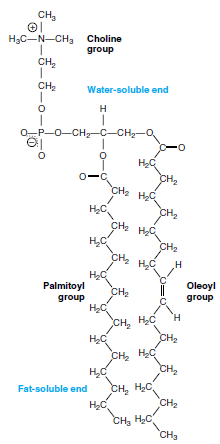Phospholipids
 |
| Figure 2-8 Lecithin (phosphatidyl choline), an important phospholipid of nerve membranes. |
Unlike the fats that are fuels and serve no structural roles in the cell, phospholipids are important components of the molecular organization of tissues, especially membranes. They resemble triglycerides in structure, except that one of the three fatty acids is replaced by phosphoric acid and an organic base. An example is lecithin, an important phospholipid of nerve membranes (Figure 2-8). Because the phosphate group on phospholipids is charged and polar and therefore soluble in water, and the remainder of the molecule is nonpolar, phospholipids can bridge two environments and bind water-soluble molecules such as proteins to water-insoluble materials.




